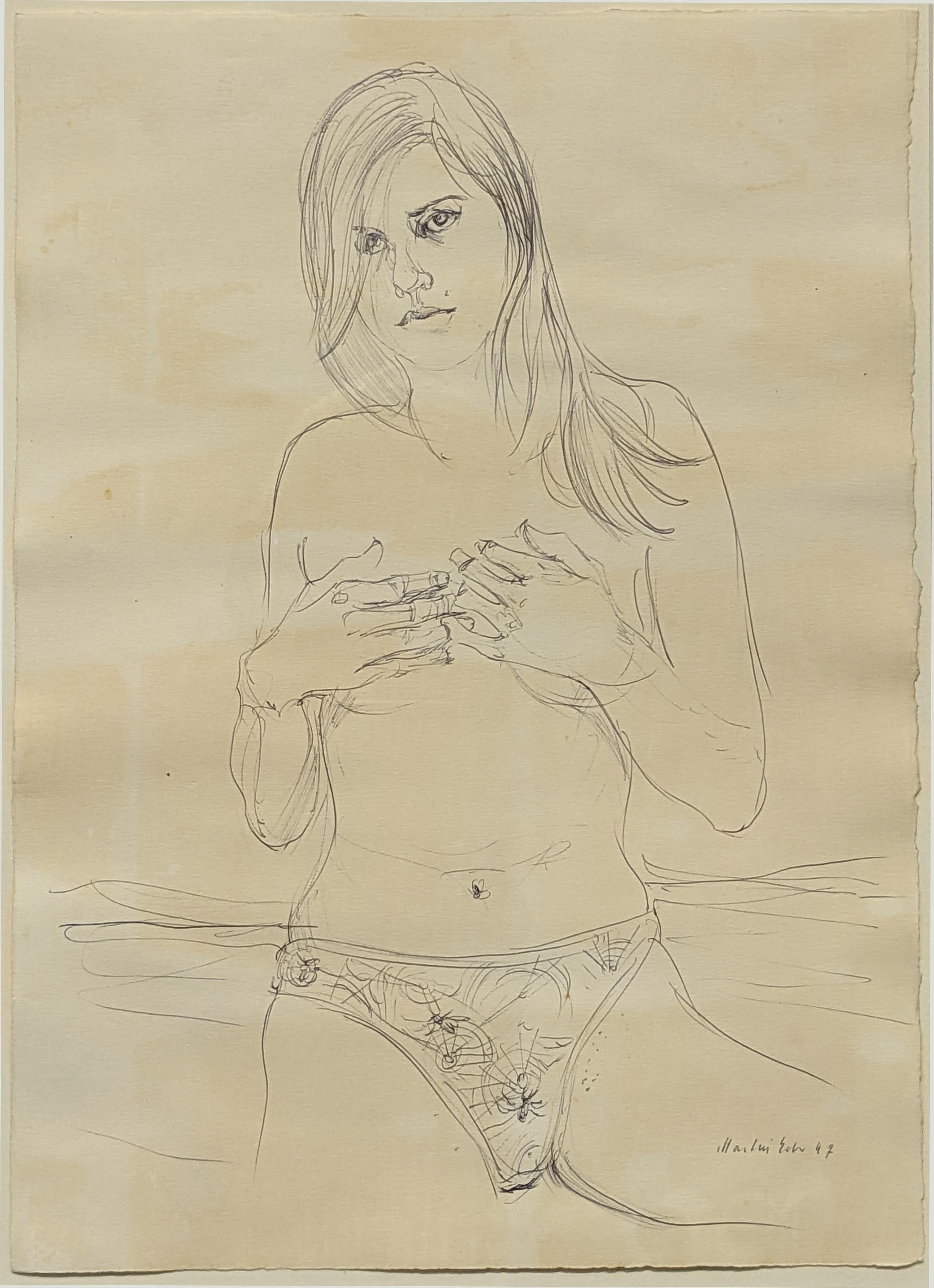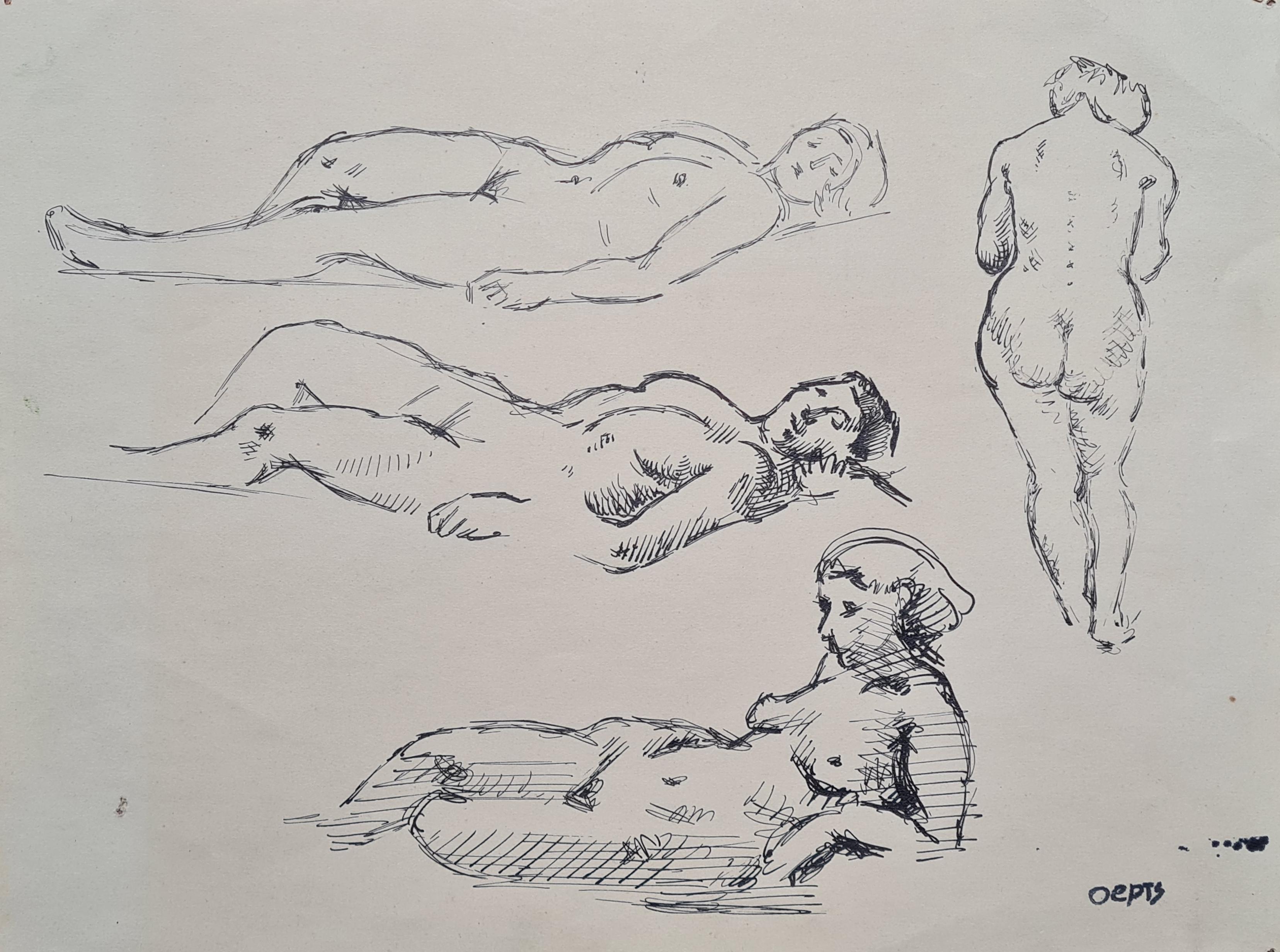Items Similar to Scientific Accuracy - British 19th Century ink illustration by George du Maurier
Want more images or videos?
Request additional images or videos from the seller
1 of 6
George du Maurier, ARWSScientific Accuracy - British 19th Century ink illustration by George du Mauriercirca 1880
circa 1880
About the Item
GEORGE DU MAURIER, ARWS
(1834-1896)
Scientific Accuracy
Ada: “What horrid things black-beetles are, Miss Grimm!
The kitchen is full of them!”
The Governess: “I agree with you, Ada!
But as they are not beetles, and not black,
perhaps you will call them cock-roaches for the future!”
Ada: “Certainly, Miss Grimm; although they are not roaches, and not cocks!”
Signed l.r.: du Maurier
Pen and ink
Framed
15.5 by 19.5 cm., 6 by 7 ¾ in.
(frame size 32.5 by 37 cm., 12 ¾ by 14 ½ in.)
Literature:
Mr Punch with The Children, The Punch, London, c.1910, p.64, illus.
George Louis Palmella Busson du Maurier was born in Paris and came to London as a student studying Chemistry at University College in 1851. He returned to Paris as an art student in 1856-7 to work under Gleyre and there made the acquaintance of Whistler and Poynter (a period of his life to feature in his novel Trilby). The loss of an eye precluded him from following a career as a painter and he decided to concentrate on black and white work. He returned to London in 1860 and took up book and magazine illustrating becoming one of the greatest social satirists of the period. From 1864 he became a regular contributor to Punch and succeeded John Leech as one of the chief observers and caricaturists of Victorian fashion and high society.
- Creator:George du Maurier, ARWS (1834 - 1896)
- Creation Year:circa 1880
- Dimensions:Height: 6.11 in (15.5 cm)Width: 7.68 in (19.5 cm)
- Medium:
- Movement & Style:
- Period:
- Condition:
- Gallery Location:London, GB
- Reference Number:

About the Seller
4.9
Vetted Seller
These experienced sellers undergo a comprehensive evaluation by our team of in-house experts.
Established in 2004
1stDibs seller since 2018
50 sales on 1stDibs
Typical response time: 15 hours
- ShippingRetrieving quote...Ships From: Banbury, United Kingdom
- Return PolicyA return for this item may be initiated within 14 days of delivery.
More From This SellerView All
- Charles Mahoney - Self Portrait, Modern British watercolour and ink drawingLocated in London, GBCHARLES MAHONEY (1903-1968) Self Portrait – A Study for Muses Signed with initials l.l. Pen and ink with sepia watercolour Framed 27.5 by 18 cm., 10 ¾ by 7 in. (frame size 46 by 3...Category
Mid-20th Century Realist Figurative Drawings and Watercolors
MaterialsInk, Watercolor
- 19th Century British Original Pen and Ink Sporting Illustration by A C CorbouldLocated in London, GBALFRED CHANTREY CORBOULD (1852-1920) “Which Way?” Signed and dated l.r.: ACCORBOULD/FEB 78 Pen and brown ink with china white heightening Un...Category
Late 19th Century Realist Animal Drawings and Watercolors
MaterialsInk
- The Travellers - 1920s British Children's book illustration by Frank WatkinsBy Frank WatkinsLocated in London, GBFRANK WATKINS (1863-1929) The Travellers Signed Pen and ink, unframed, in conservation mount only 17.5 by 26 cm., 7 by 10 ¼ in. (frame size 33.5 by 41 cm., 13 ¼ by 16 in.) Frank Henry Watkins was born in Lambeth, London and was the son of a bank clerk. He worked as a children’s book and comic illustrator in the early 20th century, drawing for many children’s stories including Dolly Twoshoes (1901); The Wonder and Dolly Daydream (1902); Illustrated Chips and Dick and Daisy (1919-1921) and also for Merry Moments. He provided book illustrations for The Man From the Moon by Philip Carmichael (1909); The Sun’s Babies by Edith Howes (1910); The King Who Never Died: Tales of King Arthur by Dorothy Senior (1910) and Fairy Rings...Category
1920s Realist Figurative Drawings and Watercolors
MaterialsInk
- Gentleman of the RoadBy Joshua Charles ArmitageLocated in London, GB“IONICUS” JOSHUA CHARLES ARMITAGE (1913-1998) Gentleman of the Road Pen and ink heightened with white, unframed, in conservation mount only 12 by 8.5 cm., 4 ¾ by 3 ¼ in. (mount si...Category
Mid-20th Century Realist Figurative Drawings and Watercolors
MaterialsInk
- Jack Escapes the Giant - 1920s British Children's illustration by Frank WatkinsBy Frank WatkinsLocated in London, GBFRANK WATKINS (1863-1929) Jack Escapes the Giant Pen and ink, unframed, in conservation mount only 24 by 29 cm., 9 ¾ by 11 ½ in. (mount size 40 by 44.5 cm., 15 ¾ by 17 ½ in.) Frank Henry Watkins was born in Lambeth, London and was the son of a bank clerk. He worked as a children’s book and comic illustrator in the early 20th century, drawing for many children’s stories including Dolly Twoshoes (1901); The Wonder and Dolly Daydream (1902); Illustrated Chips and Dick and Daisy (1919-1921) and also for Merry Moments. He provided book illustrations for The Man From the Moon by Philip Carmichael (1909); The Sun’s Babies by Edith Howes (1910); The King Who Never Died: Tales of King Arthur by Dorothy Senior (1910) and Fairy Rings...Category
1920s Realist Figurative Drawings and Watercolors
MaterialsInk
- Original 1920s British Pen and ink Children's book Illustration by Frank WatkinsBy Frank WatkinsLocated in London, GBFRANK WATKINS (1863-1929) The Boat Builder Giant Pen and ink, unframed, in conservation mount only 20.5 by 29.5 cm., 8 by 11 ¾ in. (frame size 36.5 by 45 cm., 14 ½ by 17 ¾ in.) Frank Henry Watkins was born in Lambeth, London and was the son of a bank clerk. He worked as a children’s book and comic illustrator in the early 20th century, drawing for many children’s stories including Dolly Twoshoes (1901); The Wonder and Dolly Daydream (1902); Illustrated Chips and Dick and Daisy (1919-1921) and also for Merry Moments. He provided book illustrations for The Man From the Moon by Philip Carmichael (1909); The Sun’s Babies by Edith Howes (1910); The King Who Never Died: Tales of King Arthur by Dorothy Senior (1910) and Fairy Rings...Category
1920s Realist Figurative Drawings and Watercolors
MaterialsInk
You May Also Like
- untitled / ohne TitelBy Martin EderLocated in New York, NYMartin Eder untitled work on paper executed in ballpoint pen with traces of watercolor. Ohne Titel Arbeit auf Papier, ausgeführt in Kugelschreiber mit Spuren von Aquarell. 2007Category
Early 2000s Realist Nude Drawings and Watercolors
MaterialsInk, Watercolor, Pen
- Volvo 164 - XXI Century, Contemporary Watercolor & Ink Painting, Vintage CarBy Mariusz SzałajdewiczLocated in Warsaw, PLMariusz Szalajdewicz (b. 1974) Studied at the Faculty of Architecture at Warsaw University of Technology, where he mastered the drawing skill. Arc...Category
21st Century and Contemporary Realist Figurative Drawings and Watercolors
MaterialsPaper, Ink, Watercolor
- "When They Bloom" Ink and Charcoal DrawingBy Robin ColeLocated in Denver, CORobin Cole's (US based) "When They Bloom" is an original, handmade ink and charcoal drawing that depicts two grey monochrome artichokes beginning to b...Category
2010s Realist Still-life Drawings and Watercolors
MaterialsPanel, Charcoal, Ink
- Study for femme Nue, Liggend NaaktLocated in Cotignac, FRMid 20th Century life drawing study on paper by the Dutch artist Wim Oepts. Possibly an atelier sketch for the painting, 'Liggend Naakt' from 1937 (SK054 Mon...Category
Mid-20th Century Realist Nude Drawings and Watercolors
MaterialsPaper, Ink
- Gustave Fraipont (1849-1923) A peasant girl with her flock of Turkeys, drawingBy Gustave FraipontLocated in Paris, FRGustave Fraipont (1849-1923) A Peasant girl with her flock of Turkeys, Ink and heightenings of blue watercolor on paper 23 x 15 cm Signed on the lower left and titled on lower righ...Category
1890s Realist Animal Drawings and Watercolors
MaterialsIndia Ink, Watercolor
- Louis Tinayre (1861-1942) An encampment of journalists, signed drawingLocated in Paris, FRLouis Tinayre (1861-1942) An encampment of journalists in Chambéry, signed and titled lower left "Campement de journalistes à Chambéry" Ink on paper In quite good condition, a a visible vertical fold in the centre, some stains and foxings 21 x 29 cm Framed : 33.7 x 45.5 cm Louis Tinayre's background and adventurous life obviously shed light on this humorous and detailed scene. He shows a remarkable sense of observation, capturing as a journalistic illustrator this scene of extraordianarian life. We don't know for the moment why these journalists had to improvise a camp, probably in a hotel room. No doubt it was to cover a trial or a sensational news item that had filled all the hotels in the city with journalists who had flocked for the occasion. In any case, what interests Tinayre as an almost ethnographic observer is this camp of journalists, of which he makes a tender and comical scene. One understands him better when one knows how he could be fascinated in the same way by the territories of Madagascar, the North Pole or the Far West that he painted and drew. Louis Tinayre was born on 14 March 1861 in Neuilly-sur-Seine. His mother, Victoire Tinayre, was a teacher and a member of the International Workers' Association. Louis was the son of a Communard couple. His father, Jean Joseph, known as Jules Tinayre (Issoire 1821 - Paris 1871) was shot during the Bloody Week. His mother, Victoire Tinayre, fled with her children. Louis was the first to be sent to Hungary, and the rest of the family (including his brother Julien) joined him there later. He studied Fine Arts at the Hungarian University of Fine Arts in Budapest. Returning to Paris in 1880 (after the amnesty), Louis Tinayre assiduously frequented Le Chat noir, where he met the positivists and Adèle Jacomet (Buenos Aires 1867-1946), whom he married in 1888. He became an animal painter and press illustrator and was sent by Le Monde Illustré to cover the second expedition to Madagascar (then under French protectorate) in 1895. He stayed there, fascinated, for six months and produced numerous drawings and photographs. Back in France, he created eight 5 x 4 meters dioramas presented at the National and Colonial Exhibition in Rouen in 1896. He returned to Madagascar in 1898 to prepare the creation of a giant panorama representing the surrender of Antananarivo in 1895. The Malagasy pavilion at the 1900 Universal Exhibition in Paris allowed him to admire the dioramas (on the ground floor) and the panorama (on the first floor). On his second trip, Tinayre took a Lumière cinematograph with him to document the daily life of the Malagasy people, no doubt to facilitate the design of the vast panorama. These short films were donated to the Cinémathèque française in 2009 by his grandson, Alain Tinayre. One of the admirers of Tinayre's drawings, watercolours, paintings and photographs at the Universal Exhibition was Prince Albert I of Monaco: from 1901 onwards, Tinayre accompanied him on his hunts, painting scenes in North Africa, Russia, the Far West (Wyoming) and the North Pole. Tinayre, the official painter of the Prince's scientific expeditions, left his name to a glacier. Together with the painter Alexandre Jean-Baptiste Brun, he painted the four murals in the large amphitheatre of the Oceanographic Institute in Paris. Louis Tinayre painted the figures while Alexandre Brun...Category
1890s Realist Interior Drawings and Watercolors
MaterialsInk
Recently Viewed
View AllMore Ways To Browse
British 19th
Antique Illustrations
Paris Illustration
Will George
British Kitchen
George I Frame
Illustration Children
Children Illustrations
Childrens Illustrations
Children Illustration
Childrens Illustration Art
1910 Illustration
Children Book Illustrations
Childrens Book Illustration
Black Fashion Illustration
Paris Fashion Illustration
Victorian Illustration
British Figurative Paintings 19th Century





